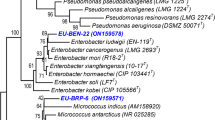Abstract
A new type of dialysis culture system was used to cocultivate different bacterial species under oligotrophic conditions. In a mineral medium with no added carbon source, the testedRhizobium leguminosarum bv.phaseoli strains outgrew anArthrobacter strain, but not anEnterobacter strain. TheRhizobium strains had generation times of approximately 4.3 h,Enterobacter agglomerans 1.5 h, andArthrobacter globiformis more than 30 h. After adding glutamate to the system to a final concentration of either 2 or 10 µM, we found significant (P < 0.05) differences in growth rates betweenRhizobium leguminosarum bv.phaseoli strains. Strains Ciat 899 and Kim5s showed maximal growth at the 10 µM glutamate concentration with generation times of 2.8 and 3.1 h, respectively. In contrast, strains Ciat 895 and CE3 reacted with increased generation times of 3.8 and 4.3 h. However, when immunofluorescence techniques were used to follow populations of the strains in an acid and a neutral tropical soil, no significant strain differences in decline were observed. Thus, strain survival in unplanted soils was not related to growth rates under oligotrophic conditions. In contrast to this, the ability to grow more or less rapidly under carbon-limited conditions was positively correlated with the known competitiveness ofRhizobium leguminosarum bv.phaseoli strains in legume host nodulation.
Similar content being viewed by others
Literature Cited
Barbour WM, Elkan GH (1990) Physiological characteristics, competitive ability of plasmid-cured derivatives ofRhizobium fredii USDA 206. Arch Microbiol 154:1–4
Beattie GA, Murray KC, Handelsman J (1989) Quantitative comparison of the laboratory and field competitiveness ofRhizobium leguminosarum biovarphaseoli. Appl Environ Microbiol 55:2755–2761
Bottomley PJ, Leung K, Strain SP, Yak K, Dashti N, Claycomp P (1990) The ecology of indigenous populations ofRhizobium leguminosarum bvs.trifolii andviceae. In: Gresshoff PM et al. (eds) Nitrogen fixation: achievements and objectives: Proceedings of the 8th International Congress on Nitrogen Fixation. New York and London: Chapman and Hall, pp 371–378
Couteaudier Y, Alabouvette C (1990) Quantitative comparison ofFusarium oxysporum competitiveness in relation to carbon utilisation. FEMS Microbiol 74:261–268
Dowling DN, Broughton WJ (1986) Competition for nodulation. Annu Rev Microbiol 40:131–157
Ensign JC (1970) Long term starvation survival of rod and spherical cells ofArthrobacter crystollopoietes. J Bacteriol 103:569–577
Eppstein E (1972) Mineral nutrition of plants and perspectives. New York, London: Wiley & Sons
Humbeck C, Werner D (1987) Two succinate uptake systems inBradyrhizobium japonicum. Curr Microbiol 14:259–262
Humbeck C, Thierfelder H, Gresshoff P, Werner D (1985) Competitive growth of slow growingRhizobium japonicum against fast growingEnterobacter andPseudomonas species at low concentrations of succinate and other substrates in dialysis culture. Arch Microbiol 142:223–228
Kingsley MT, Bohlool BB (1981) Release ofRhizobium spp. from tropical soils, recovery for immunofluorescence enummeration. Appl Environ Microbiol 42:241–248
Li D, Alexander M (1986) Bacterial growth rates and competition affect nodulation and root colonization byRhizobium melliloti. Appl Environ Microbiol 52:807–811
Lowendorf HS (1980) Factors affecting survival ofRhizobium in soil. Adv Microb Ecol 4:87–123
Lynch JM (1990) The rhizosphere. New York, London: Wiley & Sons
McDermot TR, Graham PH (1989)Bradyrhizobium japonicum inoculant mobility, nodule occupancy, and acetylene reduction in the soybean root system. Appl Environ Microbiol 55:2493–2498
McDermot TR, Graham PH (1990) Competitive ability and efficiency in nodule formation of strains ofBradyrhizobium japonicum. Appl Environ Microbiol 56:3035–3039
Nedwell DB, Gray TRG (1987) Soils and sediments as matrices for microbial growth. In: Fletcher I, Gray TRG, Jones JG (eds). Ecology of microbiological communities: Proceedings of the 41st symposium of the Society for General Microbiology. Cambridge: Cambridge University Press.
Oliveira LA, Graham PH (1990) Evaluation of strain competitiveness inRhizobium leguminosarum bvphaseoli using a nod+ fix− natural mutant. Arch Microbiol 153:305–319
Oliveira LA, Graham PH (1990) Speed of nodulation and competitive ability among strains ofRhizobium leguminosarum bv.phaseoli. Arch Microbiol 153:311–315
Pena-Cabriales JJ, Alexander M (1983) Growth ofRhizobium in soil amended with organic matter. Soil Sci Soc Am J 47:241–245
Piha MJ, Munns DN (1987) Sensitivity of the common bean (Phaseolus vulgaris L.) symbiosis to high soil temperature. Plant Soil 98:183–194
Roszak DB, Colwell RR (1987) Survival strategies of bacteria in the natural environment. Microbiol Rev 51:365–379
Somasegran P, Bohlool BB (1990) Single-strain versus multistrain inoculation: effect of soil mineral N availability on rhizobial strain effectiveness and competition for nodulation on chick-pea, soybean and dry bean. Appl Environ Microbiol 56:3298–3303
Streit W, Wolf AB, Kipe-Nolt JA, Vargas H, Werner D (1990) Survival and competition ofRhizobium leg bv.phaseoli strains. In: Gresshoff PM et al (eds) Nitrogen fixation: achievements and objectives. Proceedings of the 8th International Congress on Nitrogen Fixation. New York and London: Chapman and Hall, p 436
Thies JE, Singleton PW and Bohlool BB (1991) Influence of the size of indigenous rhizobial populations on establishment and symbiotic performance of introduced rhizobia on field grown legumes. Appl Environ Microbiol 57:19–28
Vancura V, Hanzlikova A (1972) Root exudates of plants. IV. Differences in chemical composition of seed and seedlings exudates. Plant Soil 36:271–281
Viteri SE, Schmidt EL (1987) Ecology of indigenous soil rhizobia: response ofBradyrhizobium japonicum to readily available substrates. Appl Environ Microbiol 53:1872–1875
Werner D, Wilcockson J, Zimmermann E (1975) Adsorption and selection of rhizobia by ion exchange papers. Arch Microbiol 105:27–32
Wolff AB, Streit W, Kipe-Nolt JA, Werner D (1990) Growth at low carbohydrate concentrations, survival in soil and competition ofRhizobium leguminosarum bv.phaseoli strains. In: Gresshoff PM et al. (eds) Nitrogen fixation: achievements objectives. Proceedings of the 8th International Congress on Nitrogen Fixation. New York and London: Chapman and Hall, p 441
Author information
Authors and Affiliations
Rights and permissions
About this article
Cite this article
Streit, W., Kipe-Nolt, J. & Werner, D. Competitive growth ofRhizobium leguminosarum bv.phaseoli strains under oligotrophic conditions. Current Microbiology 23, 159–163 (1991). https://doi.org/10.1007/BF02091976
Issue Date:
DOI: https://doi.org/10.1007/BF02091976




